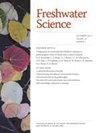Morphological plasticity in a caddisfly that co-occurs in lakes and streams
IF 1.6
4区 环境科学与生态学
Q3 ECOLOGY
引用次数: 0
Abstract
Lake and stream fauna are frequently studied, yet surprisingly little is known about ecological and evolutionary dynamics of species that inhabit both lentic and lotic habitats. There are few examples of species co-occurring in different flow types, which raises questions about how co-occurrence may influence ability to adapt to changing climatic conditions. One such co-occurring species is the aquatic insect Limnephilus externus Hagen, 1861 (Trichoptera:Limnephilidae), a species known to be widely distributed in lakes of the Nearctic and Palearctic regions. Here, we test whether lake–stream populations of the caddisfly L. externus are evolutionarily or ecologically distinct. We examined larval body and case morphology, interspecies phoretic associations, and the mitochondrial DNA cytochrome c oxidase I gene among lake and stream populations of L. externus. We also explored potential morphological differences among distinct haplotypes. We observed differences between lake and stream populations in abundance, phenology, some aspects of body and case morphology, and abdominal mite presence, indicating that lakes and streams may yield distinct ecological phenotypes for this species. We also observed distinct regional differences in caddisfly body condition and case construction sturdiness and found distinct assemblages of microinvertebrates associated with the caddisfly’s body and cases. Lake–stream L. externus did not show genetic divergence; however, 3 potentially distinct haplotypes were present across the research sites as well as in sequences from North America and Canada. Limnephilus externus appears to exhibit wide geographic range and low geographic sequence structure, which could account for the species’ large variation in phenology and morphology at the lake–stream level. Combined life history and phylogenetic studies provide valuable insight into the ecological and evolutionary dynamics that influence the adaptability of aquatic fauna to climatic change.在湖泊和溪流中共存的球蝇的形态可塑性
湖泊和溪流动物群经常被研究,但令人惊讶的是,人们对栖息在湿地和湿地栖息地的物种的生态和进化动态知之甚少。很少有物种在不同的流类型中共同发生的例子,这就提出了共同发生如何影响适应不断变化的气候条件的能力的问题。其中一个共同发生的物种是水生昆虫Limnephilus externus Hagen, 1861(毛翅目:Limnephilidae),已知该物种广泛分布于新北极和古北地区的湖泊中。在这里,我们测试了湖流种群是否在进化上或生态上是不同的。研究了湖、溪居群外源L.的幼虫体和虫体形态、种间繁殖关联以及线粒体DNA细胞色素c氧化酶I基因。我们还探索了不同单倍型之间潜在的形态差异。我们观察到湖泊和溪流种群在丰度、物候、身体和病例形态的某些方面以及腹部螨的存在方面存在差异,表明湖泊和溪流可能为该物种产生不同的生态表型。我们还观察到球虱身体状况和病例结构坚固性的明显区域差异,并发现与球虱身体和病例相关的微无脊椎动物的独特组合。湖溪外生草不存在遗传分化;然而,在整个研究地点以及北美和加拿大的序列中存在3种潜在的不同单倍型。外湖绿藻具有较宽的地理分布范围和较低的地理序列结构,这可以解释该物种在湖溪水平上物候和形态的巨大变化。结合生命史和系统发育研究为影响水生动物对气候变化适应性的生态和进化动力学提供了有价值的见解。
本文章由计算机程序翻译,如有差异,请以英文原文为准。
求助全文
约1分钟内获得全文
求助全文
来源期刊

Freshwater Science
ECOLOGY-MARINE & FRESHWATER BIOLOGY
CiteScore
4.10
自引率
0.00%
发文量
49
审稿时长
6-12 weeks
期刊介绍:
Freshwater Science (FWS) publishes articles that advance understanding and environmental stewardship of all types of inland aquatic ecosystems (lakes, rivers, streams, reservoirs, subterranean, and estuaries) and ecosystems at the interface between aquatic and terrestrial habitats (wetlands, riparian areas, and floodplains). The journal regularly features papers on a wide range of topics, including physical, chemical, and biological properties of lentic and lotic habitats; ecosystem processes; structure and dynamics of populations, communities, and ecosystems; ecology, systematics, and genetics of freshwater organisms, from bacteria to vertebrates; linkages between freshwater and other ecosystems and between freshwater ecology and other aquatic sciences; bioassessment, conservation, and restoration; environmental management; and new or novel methods for basic or applied research.
 求助内容:
求助内容: 应助结果提醒方式:
应助结果提醒方式:


